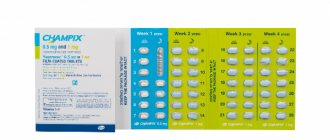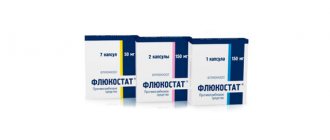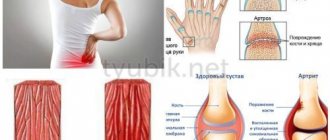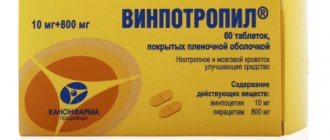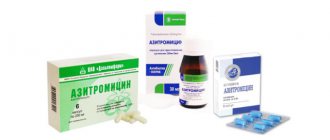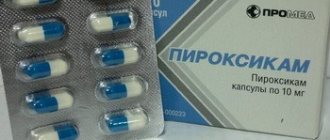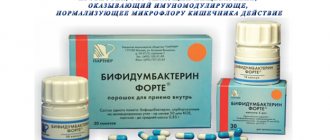Form, composition, packaging
Pilobact
The drug Pilobact contains a daily dose of a combination of several drugs from 6 chemical compounds in the form of tablets (2x2) and capsules (2), each of which is included in the packaging blister.
The packaging for the drug is a pack of cardboard, containing seven such blisters. Consists of drugs:
- Omeprazole at a concentration of 20 milligrams in capsules – 2 pieces;
- Clarithromycin at a concentration of 250 milligrams in film-coated tablets - 2 pieces;
- Tinidazole at a concentration of 500 milligrams in coated tablets - 2 pieces.
Pilobact AM
The drug is a package with a combined set of medications in a daily dose in the form of a strip, which includes:
- 2 film-coated tablets Clarithromycin 500 milligrams;
- 4 capsules of Amoxicillin 500 milligrams;
- 2 enteric capsules of Omeprazole 20 milligrams.
Each strip contains 8 items. The strips are packed in a pack of thick cardboard, 7 pieces each.
Tablets and capsules set Pilobact AM composition
Active substance: clarithromycin - 500 mg. Excipients: microcrystalline cellulose - 203 mg, povidone-35 mg, purified water* - qs, magnesium stearate -13 mg, steric acid - 22 mg, purified talc -14 mg, colloidal silicon dioxide - 12 mg, croscarmellose sodium - 61 mg.
Film shell material: hypromellose - 30 mg, hyprolose - 3 mg, propylene glycol - 6 mg, sorbitan monooleate - 2.5 mg, titanium dioxide - 3.54 mg, quinoline yellow dye - 0.142 mg, vanillin - 3.54 mg, water purified* - qs, purified talc - 2.5 mg.
Lettering ink: Opacode S-1-17823 black ink (glazed shellac-45% (20% esterified) in ethanol - 44.467% w/w, black iron oxide dye - 23.409% w/w, isopropanol - 26.882% w/w , n-butyl alcohol - 2.242% w/w, propylene glycol - 2% w/w, ammonium hydroxide 28% -1% w/w).
*lost during production
Active substance: amoxicillin trihydrate - 592.856 mg, equivalent black iron oxide - 23.409% w/w, isopropanol - 26.882% w/w, n-butyl alcohol - 2.242% w/w, propylene glycol - 2% w/w, ammonium hydroxide 28 % -1% w/w).
*lost during production
Active substance: amoxicillin trihydrate - 592.856 mg, equivalent to amoxicillin - 500 mg. Excipients: sodium lauryl sulfate - 3.12 mg, colloidal silicon dioxide - 3.12 mg, croscarmellose - 1.88 mg, microcrystalline cellulose - 17.774 mg, magnesium stearate - 6.25 mg.
Capsule shell: Cap: brilliant blue dye - 0.004 mg, azorubine dye - 0.0592 mg, quinoline yellow dye - 0.0752 mg, titanium dioxide - 0.7878 mg, methyl parahydroxybenzoate - 0.3006 mg, propyl parahydroxybenzoate - 0.0752 mg , sodium lauryl sulfate - 0.0301 mg, gelatin - 37.5806 mg.
Body: sunset yellow dye - 0.0027 mg, quinoline yellow dye - 0.2322 mg, titanium dioxide - 0.8444 mg, methyl parahydroxybenzoate - 0.4826 mg, propyl parahydroxybenzoate - 0.1206 mg, sodium lauryl sulfate - 0.0483 mg , gelatin-60.3196 mg.
Ink for writing: dehydrated alcohol* - q,s., butyl alcohol - qs, shellac - qs, iron dye black oxide qs, concentrated ammonia solution - qs, propylene glycol - qs
*lost during production
Active substance: omeprazole - 20 mg.
Excipients: Non Pareil Seeds (enteric-coated granules of sucrose and corn starch) - 61.5 mg, lactose - 80 mg, corn starch - 5 mg, mannitol - 30 mg, povidone - 15 mg, purified talc - 14, 5 mg, sodium lauryl sulfate - 11 mg, sodium dehydrated alcohol* - qs, butyl alcohol - qs, shellac - qs, black iron oxide dye - qs, concentrated ammonia solution - qs, propylene glycol - qs
*lost during production
Active substance: omeprazole - 20 mg.
Excipients: Non Pareil Seeds (granules of sucrose and corn starch, enteric coated) - 61.5 mg, lactose - 80 mg, corn starch - 5 mg, mannitol - 30 mg, povidone -15 mg, purified talc - 14, 5 mg, sodium lauryl sulfate Research Institute mg/sodium hydrogen phosphate (anhydrous) - 4.5 mg.
Enteric coating material: hypromellose phthalate - 32 mg, dichloromethane* - qs, isopropanol* - qs, diethyl phthalate - 5 mg, titanium dioxide -1.4 mg, empty hard gelatin capsule shell size No. 2 with a dark blue cap and a transparent pink body -3.25 mg.
*lost during production
Capsule shell:
Cap: brilliant blue - 0.1072 mg, carmoisin (azorubine) - 0.0107 mg, gelatin - 2 1.4 3 27 mg/ methyl parahydroxybenzoate - 0.1372 mg, propyl parahydroxybenzoate - 0.0343 mg.
Body: carmoisin (azorubine) - 0.0098 mg, gelatin - 32.7456 mg, methyl parahydroxybenzoate - 0.2096 mg, propyl parahydroxybenzoate - 0.0523 mg.
Description
Clarithromycin, film-coated tablets: light yellow, oval-shaped, biconvex, film-coated tablets with the inscription “СХТ 500” printed in black ink on one side.
Amoxicillin capsules: hard gelatin capsules, size “0 e1” (capsule cap diameter 7.57-7.71 mm, capsule body diameter 7.27-7.41 mm, capsule cap length 11.22-12.30 mm, length capsule body 19.70-20.70 mm), yellow body, brown cap with the inscription “500” printed in black ink on the cap and body. Capsule contents are white to almost white granular powder/pellets.
Omeprazole capsules: hard gelatin capsules with a “lock” size No. 2 with a dark blue cap and a transparent pink body, containing white or almost white spherical particles. granules coated with an enteric coating.
Pharmacotherapeutic group: peptic ulcer treatment
ATX code: A02BD05
Pharmacological properties
Triple therapy, including omeprazole, clarithromycin and amoxicillin, allows to achieve a high percentage of Helicobacter pylori eradication (85-94%).
Omeprazole inhibits the secretion of gastric acid due to the specific inhibition of H + K + - ATPase, an enzyme located in the membranes of parietal cells of the gastric mucosa. Reduces basal and stimulated secretion regardless of the nature of the stimulus. After a single dose of the drug nencooacter pylori (85-94%).
Omeprazole inhibits the secretion of gastric acid due to the specific inhibition of H+ IO-ATPase, an enzyme located in the membranes of parietal cells of the gastric mucosa. Reduces basal and stimulated secretion regardless of the nature of the stimulus. After a single dose of the drug orally, the effect of omeprazole occurs within the first hour and continues for 24 hours, the maximum effect is achieved after 2 hours. After stopping the drug, secretory activity is completely restored after 3-5 days.
Clarithromycin is an antibiotic from the macrolide group, a semi-synthetic derivative of erythromycin A. It has an antimicrobial effect, which is associated with the suppression of protein synthesis by interaction with the 50S ribosomal subunit of the microbial cell. Effective against a large number of gram-positive, gram-negative aerobic and anaerobic microorganisms, including H. Pylori. The metabolite 14-hydroxyclarithromycin formed in the body also has pronounced antimicrobial activity. Amoxicillin is a semi-synthetic penicillin, has a bactericidal effect and has a wide spectrum of action. The antimicrobial effect is associated with inhibition of the synthesis of peptidoglycan (the supporting polymer of the cell wall) during division and growth. Has pronounced activity against H, Pylori. H. Pylori resistance to amoxicillin is rare. The combination of amoxicillin and erythromycin has antimicrobial activity.
Amoxicillin is a semi-synthetic penicillin, has a bactericidal effect and has a wide spectrum of action. The antimicrobial effect is associated with inhibition of the synthesis of peptidoglycan (the supporting polymer of the cell wall) during division and growth. Has pronounced activity against H. Pylori. Resistance of H. Pylori to amoxicillin is rare. The combination of amokeicillin and clarithromycin has a potent antimicrobial effect against H. Pylori.
Pharmacokinetics
All three drugs included in Pilobact AM have good absorption when taken orally.
Omeprazole is rapidly absorbed after oral administration, and its bioavailability is 30-40%. Food intake does not affect the bioavailability of omeprazole. The maximum concentration of the drug in plasma (Cmax) is achieved after 0.5-1 hour. Communication with plasma proteins is 90%. Almost completely metabolized in the liver. The main route of excretion is in the urine (80%). Clarithromycin is rapidly absorbed from the gastrointestinal tract. The absolute bioavailability of 250 mg clarithromycin is approximately 50%. Eating slightly slows down the onset of absorption of clarithromycin and the formation of 14-hydroxyclarithromycin, but does not affect bioavailability. When taken on an empty stomach, peak serum concentrations are achieved within 2 hours after oral administration and are 0.6 and 0.7 mcg/ml for clarithromycin and its main metabolite. The half-life of clarithromycin is 3-4 hours.
Clarithromycin is widely distributed in the body. The concentration of clarithromycin in tissues exceeds that in serum. Protein binding ranges from 42% to 70%. It is excreted by the kidneys and in feces (20-30% in unchanged form, the rest in the form of metabolites). The simultaneous administration of clarithromycin and omeprazole improves the pharmacokinetic properties of clarithromycin: the average Cmax value increases by 10%, the minimum concentration by 15% compared with the same indicators with clarithromycin monotherapy. The concentration of clarithromycin in the gastric mucosa is also increased when administered simultaneously with omeprazole. Amoxicillin is rapidly absorbed from the gastrointestinal tract. Food intake does not affect the absorption of amokeicillin. The bioavailability of amokeicillin is 75-90%. The drug is quickly distributed in the tissues of the body. The half-life is 1-1.5 hours. Protein binding 20%. About 60% of the dose taken is excreted unchanged in the urine, a small amount is excreted in the feces.
Storage period and conditions
The acceptable storage temperature of the drug should not exceed 25 degrees. The storage location should be dry and out of reach of children. The drug Pilobact can be stored for three years, Pilobact AM can be stored for two years.
Pharmacology
The pharmacological effect of this combination of drugs is characterized as bactericidal and is aimed at combating the microorganism Helicobacter pylori.
Pharmacokinetics
There is no exact data on the pharmacokinetics of this combination drug. Presumably, this can be judged based on the pharmacokinetic abilities of each component that makes up the set separately.
Similar drugs:
- Helitriks Oral tablets
** The Drug Directory is intended for informational purposes only. For more complete information, please refer to the manufacturer's instructions. Do not self-medicate; Before starting to use the drug Pilobact AM, you should consult a doctor. EUROLAB is not responsible for the consequences caused by the use of information posted on the portal. Any information on the site does not replace medical advice and cannot serve as a guarantee of the positive effect of the drug.
Are you interested in the drug Pilobact AM? Do you want to know more detailed information or do you need a doctor's examination? Or do you need an inspection? You can make an appointment with a doctor - the Euro lab is always at your service! The best doctors will examine you, advise you, provide the necessary assistance and make a diagnosis. You can also call a doctor at home . Euro lab clinic is open for you around the clock.
** Attention! The information presented in this medication guide is intended for medical professionals and should not be used as a basis for self-medication. The description of the drug Pilobact AM is provided for informational purposes and is not intended for prescribing treatment without the participation of a doctor. Patients need to consult a specialist!
If you are interested in any other drugs and medications, their descriptions and instructions for use, information about the composition and form of release, indications for use and side effects, methods of use, prices and reviews of drugs, or you have any other questions and suggestions - write to us, we will definitely try to help you.
Pilobact indications for use
Pilobact medication sets are indicated for the eradication of Helicobacter bacteria when the patient suffers from a duodenal ulcer.
Contraindications
Pilobact
The combination drug has a number of contraindications, which the attending physician must take into account when prescribing. The main points of this list include:
- a high degree of sensitivity to each of the components of the kit or to other antibiotics of the macrolide group;
- This kit should not be prescribed for treatment when the patient is receiving drugs such as cisapride, terfenadine, pimozide, astemizole;
- alcohol consumption during treatment;
- pregnancy period;
- the entire period of breastfeeding;
- diseases of the central nervous system of organic etiology;
- porphyria;
- bone marrow hematopoiesis in a depressed state;
- renal (liver) failure;
- pediatric patients.
Pilobact AM
The combined set of medications Pilobact AM has an absolutely identical list of contraindications as the set of drugs Pilobact.
Contraindications
Absolute:
- renal and/or liver failure;
- porphyria;
- simultaneous use of terfenadine, astemizole, pimozide, cisapride;
- childhood;
- pregnancy;
- lactation period;
- individual intolerance to the components included in Pilobact AM or macrolide antibiotics.
A relative contraindication to taking the drug is simultaneous therapy with drugs metabolized by the liver.
Pilobact instructions for use
Pilobact
Each of the strips of the Pilobact combination set contains drugs that are designed for one day of use.
Taken orally twice a day, one piece of each type of drug in the morning and evening, combining with or after meals. Swallow each tablet whole, without crushing.
The duration of treatment is for a week.
Pilobact AM
In the Pilobact AM set of medications, each strip contains a daily dose of drugs for treatment and is divided into two parts: red for morning use and blue for evening use. Each colored component has corresponding inscriptions.
It is preferable to take medications before meals, without chewing for seven days.
Pilobact during pregnancy
Pilobact is not prescribed during pregnancy.
Pilobact for children
Pilobact is not recommended for use in children.
Pilobact AM set of tablets and capsules: reviews of the drug
Anastasia Kononenko, Rostov-on-Don Just recently I had a gastroscopy of my stomach and took a sample of stomach tissue. After research and testing, I was diagnosed with Helicobacter bacteria. If you don't get rid of them, it will soon lead to a stomach ulcer. The doctor prescribed me a very expensive set of drugs for treatment - a set of Pilobact AM. I purchased this drug at the pharmacy. It was necessary to take 4 pieces at once before meals, a course of 7 days. They are very large in size, and it was quite difficult for me to swallow them. I didn’t like this drug because it left an incomprehensible aftertaste of the drug, like some kind of iron. I took the course and took another test for bacteria. The drug killed them. The drug gives a quick effect, but there are also disadvantages. Dmitry Ignatenko, Dolgoprudny Somehow my stomach ached from all sides. I endured it for about two weeks, and finally decided to go to the hospital. After a bunch of tests, ultrasound and gastroendoscopy, they found a huge amount of Helicobacter pylori bacteria in me. A set of Pilobact AM was prescribed for a course of 7 days. You need to take 4 tablets at once in the morning and evening. Which is not very pleasant, although the design of this drug itself will not allow you to get confused. Red - in the morning, blue - take in the afternoon. After each use of this drug, I experienced a bitter taste in my mouth. But in general, after completing the course, tests showed the absence of these bacteria. Expensive, but really effective drug. Svetlana Miroshnikova, Kamensk-Uralsky My mother was found to have Helicobacter bacteria. As treatment, she was prescribed a set of Pilobact AM tablets and capsules. The drug is not cheap, but the complex has everything you need. They are convenient to take, but very difficult to swallow, and there are 4 more at a time. After a course of treatment, my mother’s abdominal pain stopped, but her intestinal microflora was severely damaged, and now she has to take other medications to restore it. Ivan Dorokhov, Moscow Immediately after the first dose of Pilobact AM, I started having a headache, then vomiting, and because of this the doctor stopped taking it. Ksenia Vasilyeva, Zheleznogorsk For the treatment of gastritis, since I was also diagnosed with Helicobacter bacteria, the gastroenterologist prescribed me to take the drug Pilobact AM. This drug helped me not only get rid of bacteria in just a week, but my stomach pain also disappeared! Expensive drug, but really worth it! Despite the huge list of side effects, I have not experienced a single one myself. Alexander Litvinenko, Nizhny Novgorod I was diagnosed with a duodenal ulcer many years ago, but there have been no exacerbations since then. Recently I happened to experience simply impossible pain in my stomach. I was taken away in an ambulance. After the examinations, the gastroenterologist prescribed me to take the drug Pilobact AM, which I want to say is an expensive pleasure. I took them for a week, but already on the second day the pain slowly began to go away. At the end of the course I looked like a cucumber again. The drug, as it turned out after tests, eliminates not only the symptoms, but also the very cause of these symptoms. I was pleased with the result of the treatment. Anastasia Privalova, Belgorod After treatment with Pilobact AM, which worked well in my case, I now have to treat stomatitis, which is not very pleasant.
Side effects
Since the drug Pilobact is nothing more than a set of medications, it is easy to assume that this combination will have a complete list of those side effects that are inherent in each of the components of this set.
Digestive system
A patient prescribed to take Pilobact complex should be prepared for the following side effects:
- in the form of dysbacteriosis;
- hepatitis A;
- constipation or diarrhea;
- liver dysfunction;
- nausea and vomiting;
- increased transient activity of liver enzymes in the blood plasma;
- symptoms of flatulence accompanied by pain in the abdominal area;
- development of stomatitis;
- feeling of dryness in the mouth;
- the appearance of a metallic taste in the mouth up to a complete loss of taste;
- loss of appetite.
Those patients who have had liver disease can expect to develop encephalopathy or pseudomembranous enterocolitis.
CNS
Patients often complained of the development of:
- headaches and dizziness;
- tinnitus;
- states of excitement;
- feelings of fear and nightmares in sleep;
- increased fatigue;
- the occurrence of drowsiness and weakness;
- insomnia and sleep disorders;
- psychosis;
- development of depressive states;
- disorientation;
- paresthesia;
- ataxia;
- depersonalization;
- hallucinations and confusion;
- seizures and reactions of an epileptic nature;
- peripheral neuropathies.
Musculoskeletal system
In the form of muscle weakness, arthralgia, myalgia.
Hematopoiesis
Development observed:
- thrombocytopenic purpura;
- leukopenia;
- anemia;
- neutropenia;
- thrombocytopenia.
Leather
Mostly patients complain of itching. But there are cases of skin rash. Sometimes photosensitivity, alopecia and exudative erythema multiforme were recorded.
Allergy
Allergic reactions can manifest themselves as urticaria, bronchospasm, angioedema. Anaphylactic shock is also possible.
Miscellaneous
It is also impossible not to mention isolated cases that may also occur:
- development of tachycardia;
- gynecomastia;
- interstitial nephritis;
- fever;
- visual disturbances;
- increased sweating;
- peripheral edema.
Overdose of Pilobact
Overdose can occur with any of the components of the Pilobact set.
According to Clarithromycin
Symptoms may include the development of nausea and vomiting. Diarrhea often occurs. This condition is also characterized by headaches and confusion.
Overdose should be treated with immediate gastric lavage and subsequent symptomatic treatment. Peritoneal dialysis and hemodialysis do not lead to significant results.
For Amoxicillin
Symptoms of overdose are fraught with disturbances in the water-electrolyte balance, as severe vomiting and diarrhea occur.
The patient should be treated with hemodialysis, gastric lavage and the administration of activated charcoal and saline laxatives. The victim will also need a restorative course of water and electrolyte balance.
According to Tinidazole
Conducting a course of symptomatic therapy. Hemodialysis has no effect.
Drug interactions
Due to the pronounced negative interaction, the drug combination Pilobact should not be prescribed with the following medications or caution should be exercised when combining them:
- with theophylline;
- zidovudine;
- lincomycin and clindamycin;
- terfinadine;
- indirect anticoagulants;
- carbamazepine, digoxin, cyclosporine, astemizole, phenytoin, pimozide, disopyramide, cisapride, lovastatin and valproate;
- ketocanozole, iron salts, ampicillin;
- phenobarbital, ethanol and indirect anticoagulants.
Additional instructions
Treatment should not be started until confirmation of the absence of malignant neoplasms has been received, since this therapeutic course may mask alarming symptoms.
When prescribing treatment, the doctor should pay special attention to the condition of the patient’s liver and cardiovascular system and the medications taken in connection with these ailments.
Due to taking Tinidazole, the patient's urine may become dark in color.
Drivers and other patients involved in technical activities are advised to exercise caution during their work while undergoing a treatment course with the Pilobact set of drugs.
Drug interactions
The influence of the active substances of Pilobact AM on drugs/substances when used in combination:
- theophylline: clarithromycin increases its concentration;
- terfenadine: clarithromycin increases its concentration, possibly prolonging the QT interval;
- indirect anticoagulants: clarithromycin may potentiate their effect;
- digoxin, astemizole, pimozide, cisapride, valproate, lovastatin, disopyramide, phenytoin, cyclosporine, carbamazepine: clarithromycin may increase their levels;
- warfarin, diazepam, phenytoin: omeprazole may slow down their elimination;
- iron salts, ampicillin, ketoconazole: omeprazole may affect their absorption by inhibiting gastric acid secretion;
- oral contraceptives: amoxicillin may reduce their effect.
